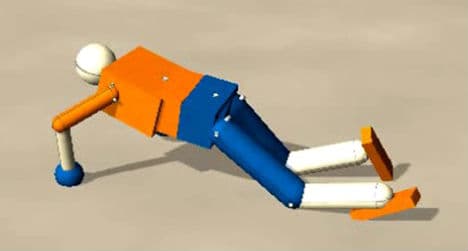Robot learns how to walk

Scientists in Austria and Germany have created a robot simulation that can independently learn how to move about and interact with other robots in its environment without any instructions.
P { margin-bottom: 0.21cm; }
Researcher Georg Martius from the Institute for Science and Technology (IST Austria) in Klosterneuburg and his colleague Ralf Der, from Max Planck Institute for Mathematics in the Sciences in Leipzig, were looking at the question of how artificial neural networks can develop autonomous, self-directed behaviour.
Simulating a human's neural network, they created “bioinspired” robots in computer simulations.
“It works just like us humans,” explained Martius. “When we touch something, a signal is transmitted to the brain, processed, and converted into a muscle movement.”
Receiving sensory input through their bodies but no tasks to complete, the robot simulations obtained feedback from the surroundings and learnt how to crawl, walk on changing surfaces and even cooperate with another robot.
This challenges the traditional theory that independent behaviour development can be explained by intrinsic motivation or curiosity.
The authors of the study published in PNAS (Proceedings of the National Academy of Science) theorise instead that self-directed behaviour can happen in the “synaptic plasticity” of the nervous system, in this case the artificial neural network.
This means that, rather than reactions being introduced by an intrinsic curiosity, a simple neural network can generate constructive movements for almost any given body.
Could help to explain evolutionary jumps
They suggested that the results can help improve understanding of evolution.
“It is commonly assumed that leaps in evolution require mutations in both the morphology and the nervous system, but the probability for both rare events to happen simultaneously is vanishingly low,” explains Martius.
“But if evolution was indeed in line with our rule, it would only require bodily mutations - a much more productive strategy. Imagine an animal just evolving from water to land. Learning how to live on land during its own life time would be very beneficial for its survival.”
Comments
See Also
P { margin-bottom: 0.21cm; }
Researcher Georg Martius from the Institute for Science and Technology (IST Austria) in Klosterneuburg and his colleague Ralf Der, from Max Planck Institute for Mathematics in the Sciences in Leipzig, were looking at the question of how artificial neural networks can develop autonomous, self-directed behaviour.
Simulating a human's neural network, they created “bioinspired” robots in computer simulations.
“It works just like us humans,” explained Martius. “When we touch something, a signal is transmitted to the brain, processed, and converted into a muscle movement.”
Receiving sensory input through their bodies but no tasks to complete, the robot simulations obtained feedback from the surroundings and learnt how to crawl, walk on changing surfaces and even cooperate with another robot.
This challenges the traditional theory that independent behaviour development can be explained by intrinsic motivation or curiosity.
The authors of the study published in PNAS (Proceedings of the National Academy of Science) theorise instead that self-directed behaviour can happen in the “synaptic plasticity” of the nervous system, in this case the artificial neural network.
This means that, rather than reactions being introduced by an intrinsic curiosity, a simple neural network can generate constructive movements for almost any given body.
Could help to explain evolutionary jumps
They suggested that the results can help improve understanding of evolution.
“It is commonly assumed that leaps in evolution require mutations in both the morphology and the nervous system, but the probability for both rare events to happen simultaneously is vanishingly low,” explains Martius.
“But if evolution was indeed in line with our rule, it would only require bodily mutations - a much more productive strategy. Imagine an animal just evolving from water to land. Learning how to live on land during its own life time would be very beneficial for its survival.”
Join the conversation in our comments section below. Share your own views and experience and if you have a question or suggestion for our journalists then email us at [email protected].
Please keep comments civil, constructive and on topic – and make sure to read our terms of use before getting involved.
Please log in here to leave a comment.